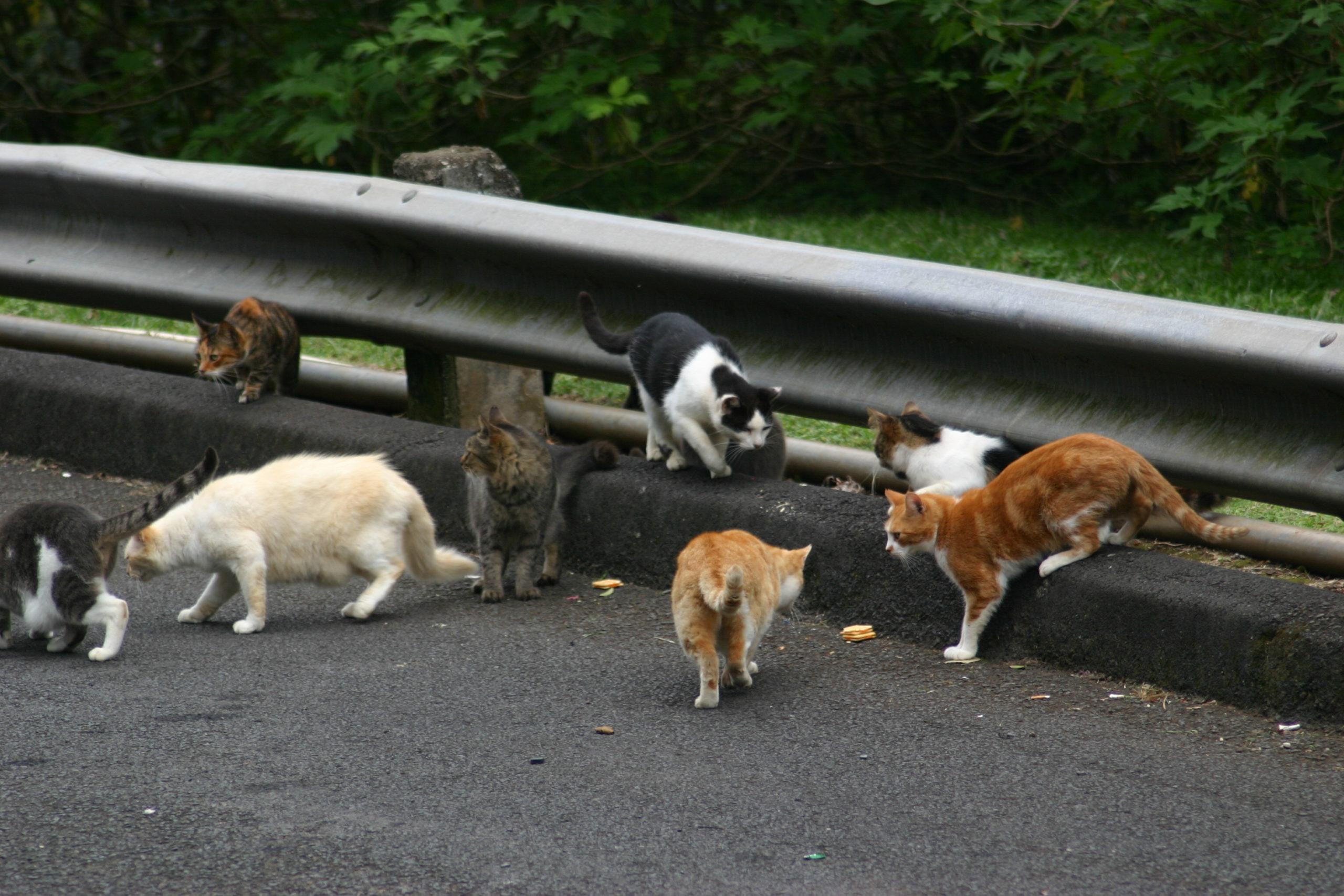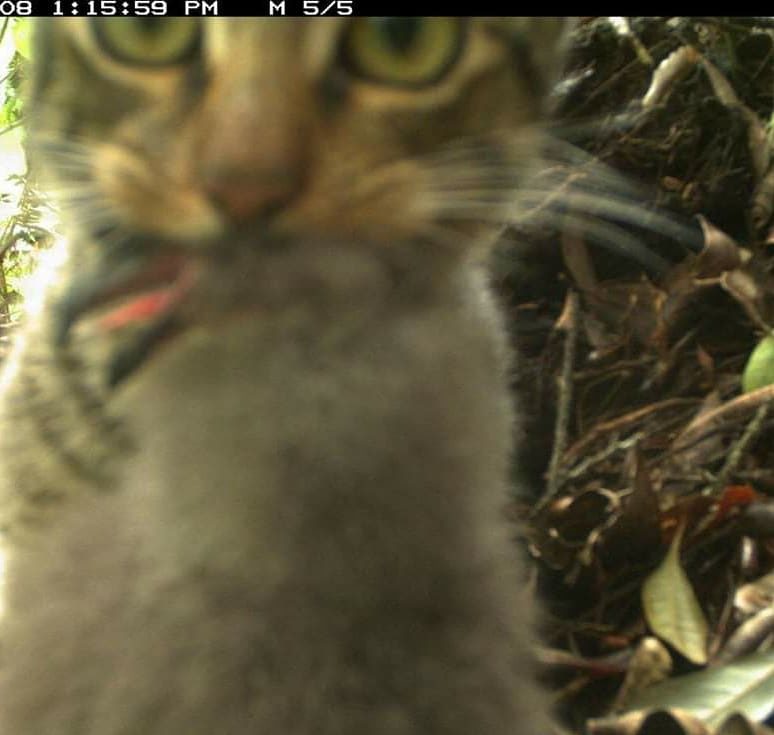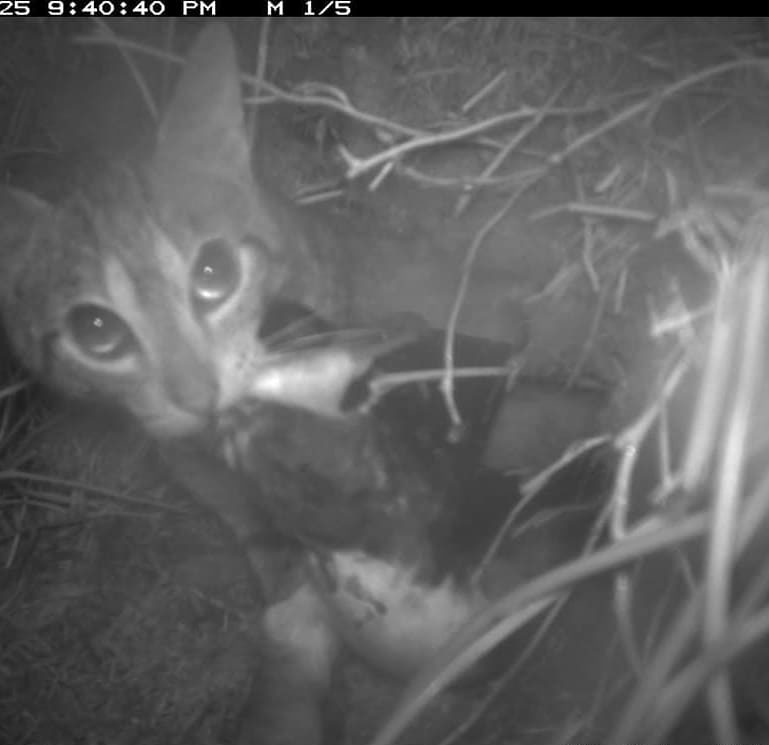
Feral Cats
More than 25% of American households claim a cat as part of the family, with nearly 62 million pet cats in households across the country. They’re certainly one of the most popular subjects of viral videos and memes! But as lovable and entertaining as cats are, unhoused and feral cats wreak havoc in the environment.
While most of the country’s cats (about 75%) live indoors as pets, a portion are stray or feral. Stray cats are abandoned domestic pets, and their offspring are known as “feral.” These cats return to a “wild” state – skittish around humans and taking on the predatory state of their larger, wild cousins. Domestic cats are not meant to be wild; they have been domesticated by humans for thousands of years to live in companionship with us. Abandoned and feral cats are at much greater risk of becoming the victims of vehicle collisions, starvation, dog attacks, disease, and even human cruelty. And for those trying to protect wildlife, feral and stray cats are themselves a threat: domestic cats are extremely successful predators, killing anywhere from 1 to 4 billion birds per year in the United States alone.

Photo: Sarah Goleman – cc
Impacts on the environment
Feral cats are known to be an invasive species all around the world, and are especially impactful in island ecosystems like Hawaii. Feral cats on islands are responsible for at least 14% of global bird, mammal, and reptile extinctions and are the principal threat to almost 8% of critically endangered species. Hawaii is the extinction capital of the United States – with over 400 species listed as threatened or endangered, and home to six bird species considered critically endangered. Wildlife specialists in Hawaii repeatedly record cats predating on nesting forest birds, marine birds, and newly hatched baby sea turtles.
Additionally, cats are the definitive host of Toxoplasma gondii, a parasite that, while not harmful to cats, can sicken and kill other organisms. In previous years multiple monk seals, ‘alalā (Hawaiian Crow), nene (Hawaiian Goose), and spinner dolphins have died from T. gondii. After the deaths of a dozen monk seals in just a few years, the National Oceanic and Atmospheric Administration concluded that this parasite is a serious threat to the Hawaiian Monk seal population. T. gondii breed in the cat’s gut and its oocysts (similar to eggs) get released along with the cat’s feces. Once in the environment, the eggs can last up to 2 years, even in saltwater. The eggs can reside in the soil and get washed into the ocean with rainwater, where monk seals accidentally ingest infected water or prey. Toxoplasmosis infection leads to a painful ordeal for the seal: severe inflammation and eventual organ failure lead to death. The infection is aggressive, fast-acting, and difficult to treat even if caught early.


Photos: Kauai Endangered Seabird Recovery
Impacts on Human & Pet Health
Toxoplasmosis gondii is also a danger for humans. Women who are infected during and even before pregnancy risk passing the parasite onto their babies. Infection can cause severe health problems, birth defects, eye disease and vision loss. Because there is no “cure” for toxoplasmosis, it is retained in the body throughout life and can be reactivated throughout a person’s life, leading to illness, ocular disease, or even changes in behavior.
Stray cats and abandoned cats are also at higher risk for diseases like feline leukemia (FeLV) and feline immunodeficiency virus (FIV), which can be transmitted to pet cats that are allowed outdoors.
1 Cat, 2 Cats, 3 Cats…
Spaying and neutering to prevent unwanted cat pregnancies is the responsibility of every pet owner. When we hear sad stories about too many cats in shelters, it’s important to remember the source: unchecked cat breeding. A key characteristic of invasive species is their ability to reach reproductive maturity quickly, and cats are no exception: at just 5 months old, cats are mature enough to breed. One female cat can give birth to up to 4 litters of kittens every year! These numbers add up very, very quickly.
What Can We Do?
Feral cats are a serious problem for Hawai‛i. But there are a few simple things that we can do to reduce the number of feral cats in our environment:
- NEVER dump or abandon a cat. Often, people believe that “dumping” a cat is more humane than taking it to a shelter. This is not true. It is dangerous, lonely, and terrifying for a pet to be abandoned. Often a cat domesticated at a very young age will lose some of their survival instincts, and can be left vulnerable if they are suddenly abandoned. Do not abandon pet cats: find them a new home, or take them to the humane society or a shelter.
- Spay/neuter your cats. There are already too many unwanted and homeless cats on our island! There are many island veterinary clinics offering spay/neuter services that are fast and affordable. If money is tight, you can also get help from a group that provide free or reduced spay/neuter services on the Big Island. Below are just a few:
- Keep pet cats indoors. Outdoor pet cats contribute to many of the wildlife problems outlined above. Even if pet cats are well fed, that doesn’t stop them from hunting. The best thing we can do is to keep them indoors. Besides helping the environment keeping cats indoors is better for their health: indoor cats live longer and are healthier than outdoor cats up (17+ years vs. just 5). Outside cats are exposed to potential dangers from accidents and diseases. Cats are perfectly happy indoors when given enough stimulation. They need a place to climb, scratch, play, and hide. Providing these things is relatively easy with cat posts and toys (or just a couple cardboard boxes). For those who want their kitty to have the ‘outdoor’ experience, they can create a ‘catio’, an enclosed outdoor space to enjoy safely.
- Do not “subsidize predation“: stray and feral cats should not be fed. Despite claims to the contrary, years of data and research have shown that Trap-Neuter-Return or “TNR” colonies are not effective in reducing outdoor cat populations. To the contrary, visible cat colonies encourage the dumping of unwanted cats, as owners assume “someone” will take care of their pet. In Hawaii, with the looming extinction of many of our native bird species, loose cat colonies are not an appropriate solution to pet overpopulation. Responsible cat lovers on other islands have found creative ways to protect both cats and wildlife in Hawaii, like this popular enclosed cat sanctuary on Lanai.
